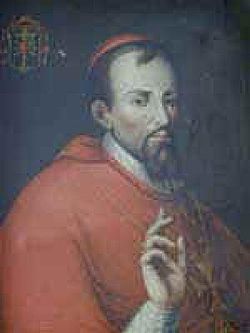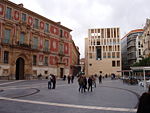
Luis Antonio Belluga y Moncada
Encyclopedia

Spain
Spain , officially the Kingdom of Spain languages]] under the European Charter for Regional or Minority Languages. In each of these, Spain's official name is as follows:;;;;;;), is a country and member state of the European Union located in southwestern Europe on the Iberian Peninsula...
churchman
Clergy
Clergy is the generic term used to describe the formal religious leadership within a given religion. A clergyman, churchman or cleric is a member of the clergy, especially one who is a priest, preacher, pastor, or other religious professional....
during the 18th century.
Born in Motril
Motril
Motril is a town and municipality on the Mediterranean coast in the province of Granada, Spain.Motril is the second largest town in the province, with a population of 59,163 as of 2008...
, Granada province
Granada (province)
Granada is a province of southern Spain, in the eastern part of the autonomous community of Andalusia. It is bordered by the provinces of Albacete, Murcia, Almería, Jaén, Córdoba, Málaga, and the Mediterranean Sea . Its capital city is also called Granada.The province covers an area of 12,635 km²...
, he was ordained at the age of 14. He served as a lector
Lector
Lector is a Latin term for one who reads, whether aloud or not. In modern languages the word has come to take various forms, as either a development or a loan, such as , , and . It has various specialized uses:...
at the cathedral of Córdoba
Córdoba, Spain
-History:The first trace of human presence in the area are remains of a Neanderthal Man, dating to c. 32,000 BC. In the 8th century BC, during the ancient Tartessos period, a pre-urban settlement existed. The population gradually learned copper and silver metallurgy...
, canon
Canon (priest)
A canon is a priest or minister who is a member of certain bodies of the Christian clergy subject to an ecclesiastical rule ....
at the cathedral of Zamora
Zamora, Spain
Zamora is a city in Castile and León, Spain, the capital of the province of Zamora. It lies on a rocky hill in the northwest, near the frontier with Portugal and crossed by the Duero river, which is some 50 km downstream as it reaches the Portuguese frontier...
, and professor in the Colegio de Santiago in Granada
Granada
Granada is a city and the capital of the province of Granada, in the autonomous community of Andalusia, Spain. Granada is located at the foot of the Sierra Nevada mountains, at the confluence of three rivers, the Beiro, the Darro and the Genil. It sits at an elevation of 738 metres above sea...
.
He supported Philip V of Spain
Philip V of Spain
Philip V was King of Spain from 15 November 1700 to 15 January 1724, when he abdicated in favor of his son Louis, and from 6 September 1724, when he assumed the throne again upon his son's death, to his death.Before his reign, Philip occupied an exalted place in the royal family of France as a...
and the Bourbons during the War of Spanish Succession, and was named by Philip bishop of Cartagena on February 9, 1705, as well as viceroy of Valencia and Murcia. Pope Clement X
Pope Clement X
Pope Clement X , born Emilio Bonaventura Altieri, was Pope from 29 April 1670 to 22 July 1676.-Early life:Emilio Altieri was born in Rome, the son of Lorenzo Altieri and Victoria Delphini, a Venetian lady...
named him cardinal on November 29, 1719. He served as Camerlengo of the Sacred College of Cardinals
Camerlengo of the Sacred College of Cardinals
The Camerlengo of the Sacred College of Cardinals was the treasurer of that body.He administered all property, fees, funds and revenue belonging to the College of Cardinals, celebrated the requiem Mass for a deceased cardinal and was charged with the registry of the Acta Consistoralia.It is...
(1728–1729), and as a crown-cardinal
Crown-cardinal
A crown-cardinal was a cardinal protector of a Catholic nation, nominated or funded by a Catholic monarch to serve as their representative within the College of Cardinals and, if applicable, exercise the jus exclusivae...
(circa 1732).

Vega Baja del Segura
Vega Baja del Segura is a comarca in the province of Alicante, Valencian Community, Spain.To the North its neighbouring comarcas are the Baix Vinalopó and Vinalopó Mitjà...
, where he initiated the colonization of uncultivated lands, founded new towns, established a seminary
Seminary
A seminary, theological college, or divinity school is an institution of secondary or post-secondary education for educating students in theology, generally to prepare them for ordination as clergy or for other ministry...
for theologians, drained swamps, and built hospices and hospitals. The Plaza del Cardenal Belluga in Murcia is named after him. The Cathedral of Murcia
Cathedral of Murcia
The Cathedral Church of Saint Mary in Murcia , commonly called the Cathedral of Murcia, is a church the city of Murcia, Spain...
, the episcopal palace of the Diocese of Cartagena, and the Town Hall (with a controversial extension to the town hall by Rafael Moneo
Rafael Moneo
José Rafael Moneo Vallés is a Spanish architect. He was born in Tudela, Spain, and won the Pritzker Prize for architecture in 1996. He studied at the ETSAM, Technical University of Madrid from which he received his architectural degree in 1961. From 1958 to 1961 he worked in the office in Madrid...
) are found on this square.
In 1736, he provided support to the Capuchin missionary
Missionary
A missionary is a member of a religious group sent into an area to do evangelism or ministries of service, such as education, literacy, social justice, health care and economic development. The word "mission" originates from 1598 when the Jesuits sent members abroad, derived from the Latin...
Francesco della Penna
Francesco della Penna
Francesco Orazio Olivieri della Penna was a Capuchin missionary to Tibet who became prefect of the Tibetan Mission.Born in Pennabilli, Della Penna entered the Capuchin monastery of Pietrarubbia...
when the latter sought help for his mission in Tibet
Tibet
Tibet is a plateau region in Asia, north-east of the Himalayas. It is the traditional homeland of the Tibetan people as well as some other ethnic groups such as Monpas, Qiang, and Lhobas, and is now also inhabited by considerable numbers of Han and Hui people...
.

